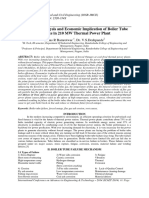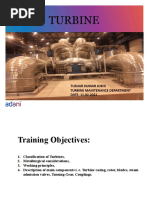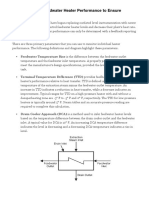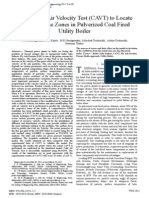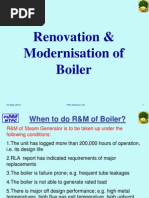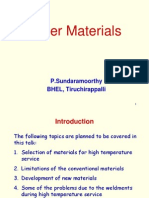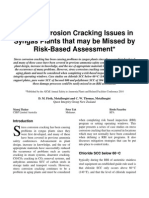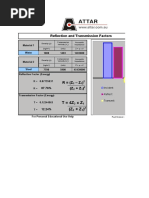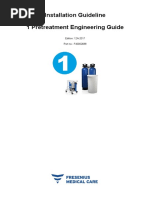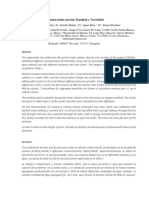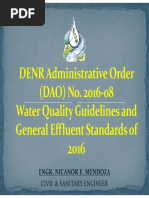Boiler RLA
Boiler RLA
Uploaded by
GaneshCopyright:
Available Formats
Boiler RLA
Boiler RLA
Uploaded by
GaneshOriginal Description:
Copyright
Available Formats
Share this document
Did you find this document useful?
Is this content inappropriate?
Copyright:
Available Formats
Boiler RLA
Boiler RLA
Uploaded by
GaneshCopyright:
Available Formats
Proceedings of the National Seminar & Exhibition
on Non-Destructive Evaluation
NDE 2011, December 8-10, 2011
PREVENTION OF CATASTROPHIC FAILURES AND BEST MAINTENANCE
OF BOILERS BY RLA & NDT
S.P. Annamalai Samy and M. Chandrangadan
NDE Inspections Trichy, Ex-Manager BHEL / ASNT NDT Level III
ABSTRACT
The Non Destructive Testing plays a key role in Boiler and critical Pressure parts maintenance and in prevention of
catastrophic failures. The safe life of Power Station Boilers and Industrial Boilers depends on the best maintenance of
boiler utilizing effective NDT Techniques during RLA Study. The effective RLA Study by able NDT Experts really
prevents catastrophic failure by giving indication in the concerned NDT in advance prior to catastrophic failure and
extends the Life of Boiler and Pressure parts. For effective RLA Study, the RLA Team must be guided and led by Team
leader with long experience and knowledge in Boiler fabrication, welding, metallurgy, design of boiler pressure parts
and expertise in NDT. And it is advisable that Team leader may be certified as ASNT / ISNT NDT Level III and
experienced since he has to take critical decision on NDT findings. The RLA Team Engineers shall be NDT specialists.
Concluding the false or non-relevant indication as crack indications by inexperienced and not properly trained persons
happens in some of the cases damaging the healthy Boiler Pressure Parts. Scanning by inexperienced persons results
in missing the possible dangerous defects in ageing Boilers. Some Catastrophic Failures can be analyzed. The Failure
analysis proves that it is due to improper NDT Evaluation. This paper explains some of such failures and how to
prevent it.
INTRODUCTION
For best maintenance of boilers, Remaining Life Assessment
Study plays a key role utilizing Non Destructive Testing. This
paper discusses how to use NDT during Fabrication, Erection
and RLA Study more effectively by NDT Techniques as health
check up of boilers, best maintenance of boilers, to extend the
life of boilers and to prevent catastrophic failure achieving
safety and continuous boiler availability.
Non Destructive Testing provides many solutions to check for
the condition monitoring of pressure parts to predict the service
induced damages if any and to check for any missed dangerous
defect during manufacturing or fabrication of critical pressure
parts. Non Destructive Testing of pressure parts during shut
down can detect the defects due to ageing, before Catastrophic
Failure - preventing forced outages of boilers by utilizing
effective Non Destructive Testing if carried out by able
experienced and trained operators,
CATASTROPHIC FAILURES
Boiler Explosion
One Boiler explosion was analyzed after Catastrophic Failure.
Surprisingly it was found that the tight side wall lack of fusion
missed in Radiography Evaluation was the culprit to cause
such a catastrophic failure as earth quake happened. It can be
seen in the photographs. Even the concrete structures which
accommodated the Boiler were damaged similar to damages
due to earth quake. The tight side wall lack of fusion was not
revealed during Radiographic inspection due to limitation of
Radiography. Hence, the manufacturers should have done
Ultrasonic Testing also in addition to Radiography. In this
Catastrophic Failure the side wall
lack of fusion in the butt joint was oriented from the outer
surface. Hence, at least the surface NDT, Magnetic Testing
should have been carried out to detect and rectify this tight
side wall lack of fusion before cleared for Radiography.
This system of NDT that is carrying out MT before clearing
for Radiography is being followed in Boiler Industry NDT. In
addition to Side Wall Lack of Fusion, it was found on analyzing
the ruptured cross section, the area below the lack of fusion is
having severe lamination also of about 300mm length where
as the ASME code permits only 75mm lamination in the
procedure and acceptance standard of UT. It is obvious that
the particular company has not used UT quality plate for boiler
fabrication.
MAIN STEAM LINE EXPLOSION
Material Mix Up
We have to follow the fool proof procedure regarding the
identification of material during manufacturing, erection and
NDE 2011, December 8-10, 2011
replacement of boiler critical pressure parts. If the carbon steel
is placed in the place of high temperature zone of alloy steel,
the carbon steel cannot with stand the temperature above 400
degree centigrade. The carbon steel will initially bulge and
result in catastrophic failure. One such failure happened in
the Main Steam Line is given in the Figure.
The colour coding system of identification of material
belonging to carbon steel and alloy steel of critical Pressure
Parts shall be successful if painted lengthwise throughout the
length of pipe and tube material. In addition to the colour
coding system by raw material suppliers, Boiler manufacturing
industry uses material analyzer during fabrication of critical
Pressure Parts. Some companies follow the system of colour
coding only at the end of the pipe and tubes. If this system is
followed, when the tube or pipe is cut at the ends, the balance
material of tube or pipe cannot be identified whether belonging
to carbon steel and alloy steel. This system of colour coding
followed in pipe material resulted in catastrophic failure of
Main Steam Line. This catastrophic failure is given in the
figures. Two spool pieces of Main Steam Line, cut and removed
from the MSL line since they have bulging. The bulged spool
pipes were doubted to be carbon steel. On analyzing by
measuring hardness and by material analyzer it was confirmed
they are carbon steel instead of P22.
BOILER OPERATION AND MAINTENANCE
Water Chemistry
Pitting Corrosion
If the DM water has dissolved oxygen, the severe pitting
corrosion shall be formed at water side of the Boiler Pressure
Parts. Photo of such severe Pitting Corrosion, formed inside
the Boiler Steam Drum is given in the Figure. Improper
chemical dozing results in heavy thick coating of water
deposits on boiler pressure parts water side, affecting heat
transfer. The Pitting Corrosion is formed at outer surface of
Boiler Drum also in some of the Sites, if the drum is not
properly covered by insulation and protected from water
entering the insulation.
Hydrogen damage in furnace tubes
459
This hydrogen damage can be scanned and predicted before
tube failure by Special Ultrasonic Technique by well
experienced and trained ASNT Level II certified personnel
guided by ASNT UT - Level III certified RLA Team Leader
since Ultrasonic Testing depends highly on operator whether
analog UT unit is used or digital UT unit is utilized for
scanning. SH tube ID oxide deposit also leads to creep failure
of high temperature SH tubes. The SH Boiler tube ID oxide
scale thickness can be measured and surveyed by using high
frequency special Ultrasonic instrument containing soft ware
for critical measurement
Ligament Crack / Thermal Fatigue Crack
Ligament Cracks occur at the ID of the high temperature
headers. The Super Heater Headers and Re-heater Headers
which are at above the creep temperature 400 degree
centigrade, develop Thermal Fatigue cracks originating from
the inner surface of the Header pipe material. The presence of
this type of cracks are initially detected by visual inspection
inside the Header pipe using video fiberscope and sized by
shear wave Ultrasonic Testing.
And a still photo from UK is given depicting catastrophic
failure due to ligament cracks in a SH Header. This catastrophic
failure could have been prevented if proper NDT / RLA were
carried out as per IBR norms. The Thermal Fatigue crack which
develop due to high temperature fluctuations and ageing, forms
in high temperature pressure parts. The mechanism of
Ligament crack formation at the ID of high temperature headers
also is Thermal Fatigue. The De-Super Heater Header is prone
for Thermal Fatigue crack. Thermal Fatigue crack detected by
Magnetic Crack Detection Testing is shown in Figure. This
belongs to one Main Steam line butt joint of 210 MW.
Boiler Water Level Maintenance
Most of the catastrophic failure in Package Boiler has
happened due to low water inside the Boiler. The water level
maintenance being critical should be maintained properly and
continuous monitoring should be followed for all type of
boilers. The boiler water level maintenance is very much
essential to prevent catastrophic failure. Water Wall furnace
tube failure due to water starvation results in fish mouth
opening of water wall tube and distortion of water wall panel.
Hydrogen + Carbon = Methane
The boiler water pH value has to be in the range of 9 to 10 to
prevent Hydrogen Damage in water wall panel tubes. If boiler
water pH value is less than 7 and acidic, the acidic deposit
gets collected at the ID of the water wall tube. The nascent
Hydrogen of atomic number one enters the ID of the water
wall tube through grain boundary. The nascent Hydrogen
entered inside the water wall tube material forms Methane
combining with carbon from carbon steel of water wall tubes.
Methane being gas exerts enormous pressure with-in the wall
thickness of the water wall tube resulting in micro fissures.
These hydrogen damaged water wall tubes will start bursting
by window opening type tube failure.
IBR Act 391a / Requirement of RLA Study
For the boilers which operate at more than the creep
temperature 400 degree centigrade, as per the Indian boiler
Regulation, carrying out RLA Study is mandatory after
1,00,000 hours operation. [After about 11.4 years of operation].
For the boilers which operate at less than the creep temperature
400 degree centigrade the RLA Study is mandatory after 25
years.
But, for both the above mentioned boilers the RLA Study has
to be repeated after every 5 years of operation as per the IBR
Act 391-A to confirm the Boiler Health and Safety.
460
Annamalai Samy and Chandrangadan: Proceedings of the National Seminar & Exhibition on Non-Destructive Evaluation
POSSIBLE DAMAGES IN AGEING BOILER PRESSURE
PARTS:
As per Electric Power Research Institute - USA
The possible damages in critical pressure parts due to ageing
and various damage mechanisms are given below. The
concerned effective NDT method to detect the service induced
damages in boiler critical Pressure Parts also are tabulated
below.
Sl. No.
Name of
Pressure Part
01 Boiler Drum
Damage
Mechansim
Effective
NDT Methods
Thermal
Fatigue
MT / WFMT
02 High temperature
Irreversible
Field
Headers S.H Headers,
Creep
Metallography
Re-Heater Headers
damage
to assess level
De-Super heater
due to high
of creep
[above 400C]
temperature
damage
and Pressure
MT
Thermal
Critical
Fatigue Crack Shear wave
in butt
Ultrasonic
weld
scanning
03 High temperature
Headers S.H Headers,
Re-Heater Headers
Ligament
crack at ID
of header
pipe
Video
Fiberscope
& Shear wave
Ultrasonic
Scanning
04 S.H Coils and RH. Coils Tube ID
High
oxide deposit
frequency
leads to creep Ultrasonic
damage.
scanning and
Tube sample
analysis.
05 Main Steam Line
06 Furnace Water
Wall Tubes
Creep damage
Field
and Thermal Metallography,
Fatigue due above 400C.
to high
temperature
MT
Critical Shear
wave Ultrasonic
scanning
Hydrogen
Damage
Special
Ultrasonic
Scanning
Magnetic Crack Detection Testing
Magnetic Crack detection Testing is more effective for
examining surface cracks on Boiler Pressure Parts of
ferromagnetic materials since PT can not reveal cracks which
are contaminated in ageing Boiler Pressure Parts. Most of the
service induced cracks originate from surface. Hence, MT
using AC has more sensitivity to detect service induced surface
crack since the magnetic field is more concentrated on surface.
The limitation of PT is it cannot detect the defects, even open
to surface with contamination. We can employ PT on nonmagnetic materials to detect surface open defects and cracks
after thorough cleaning and removing the contamination a
time consuming process.
NDE 2011, December 8-10, 2011
Ultrasonic Testing
Radiographic Testing is more sensitive to reveal volumnar
defects like gas holes and slag. But, the aim of RLA Study is
to detect the possible service induced crack like indications
due to thermal fatigue or irreversible creep damage, etc.
Ultrasonic Testing is more sensitive in detecting tight lack of
fusion and cracks like Fatigue crack, creep crack, Hydrogen
induced Crack and any other crack like indications. The service
induced cracks like Thermal Fatigue Crack and Creep Crack
will be tight in nature. Since, Radiography can not reveal tight
cracks, during RLA Study, Ultrasonic scanning is more
effectively employed. But, UT is highly operator dependent.
CONCLUSION
The RLA Team shall be led by a well experienced NDT Expert,
certified as NDT Level III in the applicable methods with
knowledge and experience in damage mechanisms in ageing
Boiler pressure parts and effective NDT Techniques. Since
Interpretation and Evaluation of NDT findings are critical and
require well experienced RLA Study Team Leader and Team
Members. the RLA Team leader responsibility is entrusted to
ASNT NDT Level III certified Engineer in Electric Power
461
Research Institute USA. Other RLA Team Members also
shall be certified as NDT - Level II and well trained and
experienced.
Knowledge and experience in Boiler Design, critical Pressure
Parts fabrication, welding, Boiler operation and metallurgy
are essential to carry out the RLA Study effectively. Utilising
quality sensitive calibrated NDT Instruments and consumables
also are mandatory.
REFERENCES
1.
2.
3.
NDE of Fossil Plants EPRI - Electric Power Research
Institute USA
Akalanks INDIAN BOILER REGULATIONS, 2008
IBR Act 391A Ageing of Boilers.
2010 ASME Boiler & Pressure Vessel Code Sec.V
Article - 23 SA-435 / SA-435M
4.
Power Plant Engineering. - STEAM AND NUCLEAR
P.K. NAG
5.
Ultrasonic Thickness Measurement of Internal Oxide
Scale in Steam Boiler Tubes Steve Labreck, Dan Kass
and Tom Nellingan, Olympus NDT, Waltham MA, USA
You might also like
- Qp-Ohh-Std-012 QP Standard For Managing Heat StressDocument12 pagesQp-Ohh-Std-012 QP Standard For Managing Heat StressSubbu AbuNo ratings yet
- H-3 Power Point (Air Heater)Document63 pagesH-3 Power Point (Air Heater)wisokresno100% (1)
- Superheater and Reheater Outlet Header Inspections FailuresDocument65 pagesSuperheater and Reheater Outlet Header Inspections Failureskaruna346No ratings yet
- Boilers RLADocument60 pagesBoilers RLAGanesh100% (1)
- G Writereaddata Eia 25042018sjwszk2mcp&empDocument43 pagesG Writereaddata Eia 25042018sjwszk2mcp&empROHAN JHANDANo ratings yet
- MSDS Mazda Original Oil Ultra 5W30Document13 pagesMSDS Mazda Original Oil Ultra 5W30GanNo ratings yet
- Analysis of Boiler Tube FailureDocument6 pagesAnalysis of Boiler Tube FailureInternational Journal of Innovative Science and Research Technology100% (1)
- RCA of Boiler Tube Failure in 210 MW PlantDocument5 pagesRCA of Boiler Tube Failure in 210 MW PlantAnsuman Sen Sharma50% (2)
- RLA in High Temp Zones of Power Plant ComponentsDocument7 pagesRLA in High Temp Zones of Power Plant ComponentsEzhil Vendhan PalanisamyNo ratings yet
- Advanced Material For Ultra Super Critical Boiler SystemDocument2 pagesAdvanced Material For Ultra Super Critical Boiler SystemgaotamaNo ratings yet
- Analysis of Tube Failure in Water Tube BoilerDocument16 pagesAnalysis of Tube Failure in Water Tube BoilerHussseinmubarkNo ratings yet
- Familiarization of Thermal Power Plant With CFBC BoilerDocument21 pagesFamiliarization of Thermal Power Plant With CFBC BoilerAnudeep ChittluriNo ratings yet
- Factors That Affect CFBC Panel Erosion by K.K.parthibanDocument34 pagesFactors That Affect CFBC Panel Erosion by K.K.parthibanparthi20065768100% (2)
- Boiler Tube MaterialsDocument12 pagesBoiler Tube MaterialsSnehashis MaityNo ratings yet
- Failure Investigation of Super Heater Tubes of CoaDocument24 pagesFailure Investigation of Super Heater Tubes of CoaMahsaNo ratings yet
- Report TaqaDocument15 pagesReport Taqaraghunandanr1993No ratings yet
- CAVTDocument4 pagesCAVTRaj EaswarmoorthiNo ratings yet
- Fact Sheet STEAG Power Plant Learning Center India 03Document2 pagesFact Sheet STEAG Power Plant Learning Center India 03sourav mahapatraNo ratings yet
- Tube Fail 1Document29 pagesTube Fail 1Sam100% (1)
- Turbine Operational ProblemsDocument35 pagesTurbine Operational Problemsna2011100% (2)
- 1314276003newsletter Reduce Boiler Tube Leakages in Your Power StationDocument7 pages1314276003newsletter Reduce Boiler Tube Leakages in Your Power StationNorman IskandarNo ratings yet
- Soot Blowers Keep The Heat Transfer Surfaces in A Boiler CleanDocument50 pagesSoot Blowers Keep The Heat Transfer Surfaces in A Boiler Cleanajanthalakshmi100% (1)
- National Power Training Institute: by NPTI InstitutesDocument39 pagesNational Power Training Institute: by NPTI InstitutesdondasscribdNo ratings yet
- Finding The Root Cause of Boiler Tube FailuresDocument17 pagesFinding The Root Cause of Boiler Tube Failuresjgv100% (1)
- Boiler Types and ClassificationsDocument26 pagesBoiler Types and ClassificationshardikNo ratings yet
- SuperCritical Boiler 1Document45 pagesSuperCritical Boiler 1swatantar17100% (1)
- Design Parameters Steam TurbineDocument25 pagesDesign Parameters Steam TurbineeshanrastogiNo ratings yet
- Turbine Working & ItsComponentsDocument88 pagesTurbine Working & ItsComponentsHimanshu spolia100% (4)
- FMEA Boiler TubeDocument8 pagesFMEA Boiler TubeRituraj SinghNo ratings yet
- 08 - Erosion Protection Measu 210911Document12 pages08 - Erosion Protection Measu 210911Lakshmi NarayanNo ratings yet
- Monitor Feedwater Heater PerformanceDocument1 pageMonitor Feedwater Heater PerformanceknsaravanaNo ratings yet
- Boiler Inspection - DailyDocument31 pagesBoiler Inspection - DailySumitskb100% (2)
- Thermal PowerDocument44 pagesThermal PowerAnonymous W9VINoTzaNo ratings yet
- Use of Cold Air Velocity Test (CAVT) To Locate Erosion Prone Zones in Pulverized Coal Fired Utility BoilerDocument5 pagesUse of Cold Air Velocity Test (CAVT) To Locate Erosion Prone Zones in Pulverized Coal Fired Utility BoilerVinoth KumarNo ratings yet
- Super Critical BoilerDocument78 pagesSuper Critical BoilerSam100% (3)
- Energy Audit Methodology For FOR Turbine Cycle: M.V.Pande Dy - Director NPTI, NagpurDocument33 pagesEnergy Audit Methodology For FOR Turbine Cycle: M.V.Pande Dy - Director NPTI, NagpurKrishnan Santhanaraj100% (2)
- Managing Exfoliation in Super Critical BoilersDocument11 pagesManaging Exfoliation in Super Critical BoilersDebabrata Ghosh100% (1)
- Training R&M of BoilersDocument45 pagesTraining R&M of BoilersSam100% (1)
- At M/S Jindal Steel &power Limited: For More ProjectsDocument26 pagesAt M/S Jindal Steel &power Limited: For More ProjectsvasqueznvNo ratings yet
- Vizag Steel Plant WHRB RussiaDocument47 pagesVizag Steel Plant WHRB RussiakaustavNo ratings yet
- Supercritical PMIDocument76 pagesSupercritical PMIVinod Mahajan100% (1)
- Boiler MaterialsDocument47 pagesBoiler MaterialsSaptarshi Sengupta100% (1)
- Power Plant Performance AnalyticsDocument30 pagesPower Plant Performance AnalyticsMunib100% (1)
- Line TraceDocument84 pagesLine TraceDataRam GurjarNo ratings yet
- Boiler QuestionsDocument14 pagesBoiler QuestionsLamheNo ratings yet
- Compressed Air System Gyanendra Sharma Npti DelhiDocument12 pagesCompressed Air System Gyanendra Sharma Npti DelhiNPTINo ratings yet
- Paper 6 Chem Cleaning Edta BhelDocument39 pagesPaper 6 Chem Cleaning Edta BhelVIBHAV100% (2)
- Fine Tuning A CFBC Boiler PDFDocument12 pagesFine Tuning A CFBC Boiler PDFrikumohanNo ratings yet
- Techno Energy Engineering Pvt. Ltd. IntroductionDocument6 pagesTechno Energy Engineering Pvt. Ltd. IntroductionTechnoEnergyNo ratings yet
- Presentation Title Mundra UMPP: Presentation Subtitle CGPL, Tata Power Company LimitedDocument34 pagesPresentation Title Mundra UMPP: Presentation Subtitle CGPL, Tata Power Company LimitedJay JobanputraNo ratings yet
- Boiler Tube Failure and ImpactsDocument8 pagesBoiler Tube Failure and ImpactsUdhayakumar VenkataramanNo ratings yet
- Boiler Tube Failure Analysis - 1Document7 pagesBoiler Tube Failure Analysis - 1SrinivasaNo ratings yet
- Coal Mill in Thermal Power PlantDocument3 pagesCoal Mill in Thermal Power Plantkiki270977No ratings yet
- Presented By: Souvanik Chakravorty S Anil Kumar Tatithuri G SrikantDocument30 pagesPresented By: Souvanik Chakravorty S Anil Kumar Tatithuri G Srikants anil kumar tatithuriNo ratings yet
- Pressure Parts 500MW BoilerDocument34 pagesPressure Parts 500MW BoilerAbhay Khobragade100% (2)
- Engineering Bulletin No 1: Boiler and Furnace TestingFrom EverandEngineering Bulletin No 1: Boiler and Furnace TestingRating: 4.5 out of 5 stars4.5/5 (2)
- Steam Boiler Inspections Using Remote Field Testing: by Mynor Celis, P.Eng, Russell NDE SystemsDocument11 pagesSteam Boiler Inspections Using Remote Field Testing: by Mynor Celis, P.Eng, Russell NDE SystemsAnonymous lmCR3SkPrKNo ratings yet
- Residual Life Assessment and Failure of The BoilerDocument21 pagesResidual Life Assessment and Failure of The Boilernagasuresh100% (1)
- Stress Corrosion Cracking Issues in Syngas PlantsDocument12 pagesStress Corrosion Cracking Issues in Syngas PlantsciaoNo ratings yet
- Integrated Approach RLA of Reformer Tubes NDT (ARTiS) PDFDocument8 pagesIntegrated Approach RLA of Reformer Tubes NDT (ARTiS) PDFSatya RaoNo ratings yet
- Residual Life Assessment and Failure of The BoilerDocument21 pagesResidual Life Assessment and Failure of The BoilernagasureshNo ratings yet
- Boiler Tubes Overheating Failures and Actions To Control ThemDocument2 pagesBoiler Tubes Overheating Failures and Actions To Control ThemThanhluan NguyenNo ratings yet
- BR 170 1Document7 pagesBR 170 1Himanshu ChaturvediNo ratings yet
- AS3788 Appendix N - Assessment of Wall Thinning: Input Data CalculationsDocument5 pagesAS3788 Appendix N - Assessment of Wall Thinning: Input Data CalculationsGaneshNo ratings yet
- Ultrasonics Accoustic ImpedanceDocument2 pagesUltrasonics Accoustic ImpedanceGaneshNo ratings yet
- AS3788 Appendix N - Assessment of Wall Thinning: Input Data CalculationsDocument5 pagesAS3788 Appendix N - Assessment of Wall Thinning: Input Data CalculationsGaneshNo ratings yet
- Acoustic EmissionDocument39 pagesAcoustic Emissiongovindarajan017No ratings yet
- Requirements For Life Extension of Ageing Offshore Production InstallationsDocument54 pagesRequirements For Life Extension of Ageing Offshore Production InstallationsGaneshNo ratings yet
- Lecture 1 - HydrologyDocument4 pagesLecture 1 - HydrologySaad ShauketNo ratings yet
- Coca Cola MatrixDocument23 pagesCoca Cola MatrixAnanditaKarNo ratings yet
- Transcaer - Ammonia - Training - 2011 EmergencyResponse - IG - Rev14Document28 pagesTranscaer - Ammonia - Training - 2011 EmergencyResponse - IG - Rev14julianopetry10No ratings yet
- SIWADocument1 pageSIWAMahmoudNo ratings yet
- Chola Aqua Technologies & Services: Mandaveli, Chennai - 600 028Document3 pagesChola Aqua Technologies & Services: Mandaveli, Chennai - 600 028jeykumar.BalannairNo ratings yet
- UntitledDocument6 pagesUntitledNimish GoyalNo ratings yet
- Plumbing 2Document24 pagesPlumbing 2freanne_0527100% (1)
- Immediate Download The Nalco Water Handbook Fourth Edition Nalco Company Ebooks 2024Document54 pagesImmediate Download The Nalco Water Handbook Fourth Edition Nalco Company Ebooks 2024vitkaytsaoNo ratings yet
- L-4 Nature and Genesis of Unsaturated SoilsDocument32 pagesL-4 Nature and Genesis of Unsaturated SoilsAshebirNo ratings yet
- Gender and Climate ChangeDocument12 pagesGender and Climate ChangeAshley MaenzaniseNo ratings yet
- Installation Guideline 1 Pretreatment Engineering Guide: Edition: 12A-2017 Part No.: F40002688Document145 pagesInstallation Guideline 1 Pretreatment Engineering Guide: Edition: 12A-2017 Part No.: F40002688Aleksei PodkopaevNo ratings yet
- Column Pumps - LowaraDocument100 pagesColumn Pumps - LowarayutNo ratings yet
- Lecture 9: Evaporation: Key QuestionsDocument52 pagesLecture 9: Evaporation: Key QuestionsMusa KizitoNo ratings yet
- Sikaflex-260 N eDocument2 pagesSikaflex-260 N eTrung Trinh BaoNo ratings yet
- Labconco 7934040 User-Service Manual PDFDocument82 pagesLabconco 7934040 User-Service Manual PDFfelix bazanNo ratings yet
- Aquatic CenterDocument71 pagesAquatic CenterJanzeth L. SacmarNo ratings yet
- Vinilex Wall SealerDocument17 pagesVinilex Wall SealerRonaldo glenn SinabaribaNo ratings yet
- Waste ManagementDocument7 pagesWaste Managementwongsc70No ratings yet
- 30TAC290 Sub D - Rules and Regulations For Public Water SystemsDocument118 pages30TAC290 Sub D - Rules and Regulations For Public Water SystemsjcreinmanNo ratings yet
- Volumen Molar Parcial, Densidad y ViscosidadDocument8 pagesVolumen Molar Parcial, Densidad y ViscosidadMichelle CastilloNo ratings yet
- Indigo Water Resuse Looptec 6 Print NomarksDocument4 pagesIndigo Water Resuse Looptec 6 Print NomarksAwais ImranNo ratings yet
- Valquatight Gasket: Valqua No. 6590 Product Name BLACKTIGHT (Basic Design)Document5 pagesValquatight Gasket: Valqua No. 6590 Product Name BLACKTIGHT (Basic Design)성수길No ratings yet
- Chapter - 1. IntroductionDocument21 pagesChapter - 1. IntroductionSiddhi PatilNo ratings yet
- Earth and Life Science: Quarter 2 - Module 2: Natural HazardsDocument23 pagesEarth and Life Science: Quarter 2 - Module 2: Natural HazardsRachel Ann CanlasNo ratings yet
- Suratgarh Super Thermal Power Station: Name: Puneet KulriaDocument30 pagesSuratgarh Super Thermal Power Station: Name: Puneet Kulriapreetika100% (1)
- Technical Specifications PT. MBJ Rev.2Document68 pagesTechnical Specifications PT. MBJ Rev.2koko sri handokoNo ratings yet
- Denr Administrative Order No 2016-08 Final Presentation Sept Oct 2022Document80 pagesDenr Administrative Order No 2016-08 Final Presentation Sept Oct 2022Hendrix LevaNo ratings yet








